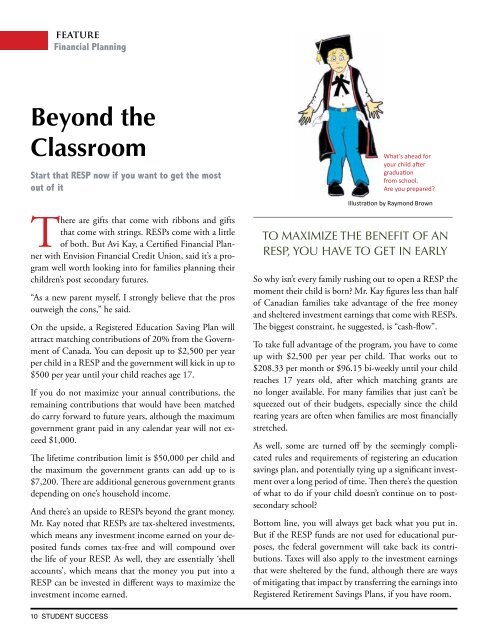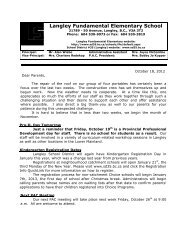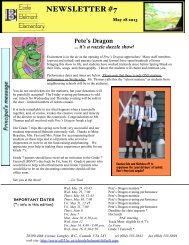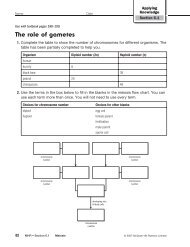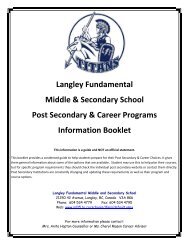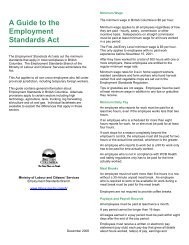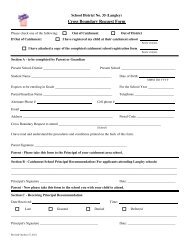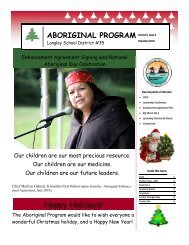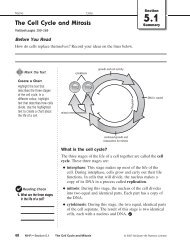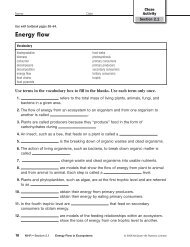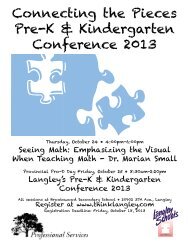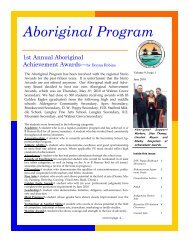Secondary Schools - School District #35
Secondary Schools - School District #35
Secondary Schools - School District #35
Create successful ePaper yourself
Turn your PDF publications into a flip-book with our unique Google optimized e-Paper software.
feature<br />
Financial Planning<br />
Beyond the<br />
Classroom<br />
Start that RESP now if you want to get the most<br />
out of it<br />
There are gifts that come with ribbons and gifts<br />
that come with strings. RESPs come with a little<br />
of both. But Avi Kay, a Certified Financial Planner<br />
with Envision Financial Credit Union, said it’s a program<br />
well worth looking into for families planning their<br />
children’s post secondary futures.<br />
“As a new parent myself, I strongly believe that the pros<br />
outweigh the cons,” he said.<br />
On the upside, a Registered Education Saving Plan will<br />
attract matching contributions of 20% from the Government<br />
of Canada. You can deposit up to $2,500 per year<br />
per child in a RESP and the government will kick in up to<br />
$500 per year until your child reaches age 17.<br />
If you do not maximize your annual contributions, the<br />
remaining contributions that would have been matched<br />
do carry forward to future years, although the maximum<br />
government grant paid in any calendar year will not exceed<br />
$1,000.<br />
The lifetime contribution limit is $50,000 per child and<br />
the maximum the government grants can add up to is<br />
$7,200. There are additional generous government grants<br />
depending on one’s household income.<br />
And there’s an upside to RESPs beyond the grant money.<br />
Mr. Kay noted that RESPs are tax-sheltered investments,<br />
which means any investment income earned on your deposited<br />
funds comes tax-free and will compound over<br />
the life of your RESP. As well, they are essentially ‘shell<br />
accounts’, which means that the money you put into a<br />
RESP can be invested in different ways to maximize the<br />
investment income earned.<br />
What’s ahead for<br />
your child after<br />
graduation<br />
from school.<br />
Are you prepared<br />
Illustration by Raymond Brown<br />
To maximize the benefit of an<br />
RESP, you have to get in early<br />
So why isn’t every family rushing out to open a RESP the<br />
moment their child is born Mr. Kay figures less than half<br />
of Canadian families take advantage of the free money<br />
and sheltered investment earnings that come with RESPs.<br />
The biggest constraint, he suggested, is “cash-flow”.<br />
To take full advantage of the program, you have to come<br />
up with $2,500 per year per child. That works out to<br />
$208.33 per month or $96.15 bi-weekly until your child<br />
reaches 17 years old, after which matching grants are<br />
no longer available. For many families that just can’t be<br />
squeezed out of their budgets, especially since the child<br />
rearing years are often when families are most financially<br />
stretched.<br />
As well, some are turned off by the seemingly complicated<br />
rules and requirements of registering an education<br />
savings plan, and potentially tying up a significant investment<br />
over a long period of time. Then there’s the question<br />
of what to do if your child doesn’t continue on to postsecondary<br />
school<br />
Bottom line, you will always get back what you put in.<br />
But if the RESP funds are not used for educational purposes,<br />
the federal government will take back its contributions.<br />
Taxes will also apply to the investment earnings<br />
that were sheltered by the fund, although there are ways<br />
of mitigating that impact by transferring the earnings into<br />
Registered Retirement Savings Plans, if you have room.<br />
10 Student Success


